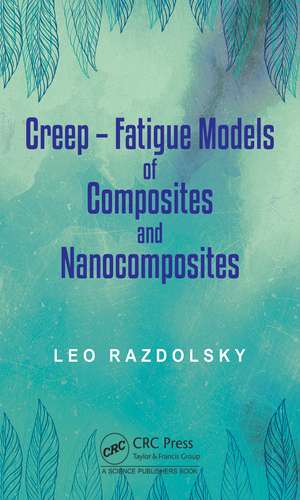Creep: Fatigue Models of Composites and Nanocomposites
Autor Leo Razdolskyen Limba Engleză Hardback – 4 aug 2023
The book presents new phenomenological cyclic creep – fatigue models for describing the fatigue life and behavior of time-dependent composites and nanocomposites. Since the main difference between the creep process from the fatigue process is that from a physical point of view, the first is quasi-static, and the second is dynamic. Therefore, the functions of creep should reflect the oscillatory nature of the fatigue process. The results are supported by step-by-step practical design examples and will be useful for practicing structural engineers, code developers as well as research and university faculty.
Preț: 762.48 lei
Preț vechi: 1029.00 lei
-26% Nou
Puncte Express: 1144
Preț estimativ în valută:
145.93€ • 153.95$ • 121.61£
145.93€ • 153.95$ • 121.61£
Carte tipărită la comandă
Livrare economică 02-16 ianuarie 25
Preluare comenzi: 021 569.72.76
Specificații
ISBN-13: 9781032213019
ISBN-10: 1032213019
Pagini: 240
Ilustrații: 29 Tables, black and white; 52 Line drawings, black and white; 52 Illustrations, black and white
Dimensiuni: 156 x 234 x 14 mm
Greutate: 0.6 kg
Ediția:1
Editura: CRC Press
Colecția CRC Press
ISBN-10: 1032213019
Pagini: 240
Ilustrații: 29 Tables, black and white; 52 Line drawings, black and white; 52 Illustrations, black and white
Dimensiuni: 156 x 234 x 14 mm
Greutate: 0.6 kg
Ediția:1
Editura: CRC Press
Colecția CRC Press
Public țintă
GeneralCuprins
Introduction and Assumptions. Cumulative Damage Model (CDM) of cyclic creep – fatigue process. Phenomenological Creep – Fatigue Models. Peculiarities of Phenomenological Models of Nanocomposites. Probabilistic Approach of Creep – Fatigue Models.
Notă biografică
Leo Razdolsky has forty-five years of experience in structural engineering. His experience includes material science; computer modeling; composite and nanocomposite structures, power plants and cooling towers. Dr. Razdolsky has been teaching various structural engineering and material science courses at the University of Illinois and Northwestern University. Dr. Razdolsky is currently an independent researcher conducting research work connected with high temperature creep of composite structural elements and systems. He is the author of four books in this area of expertise.
Descriere
The book presents new phenomenological cyclic creep – fatigue models for describing the fatigue life and behavior of time-dependent composites and nanocomposites. Certain criteria imposed on selecting the creep functions that has the potential of describing a wide range of materials behavior.
